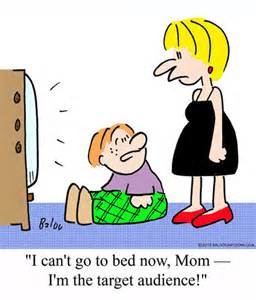From the Principal’s Desk:
Taking Charge of TV 
By the time they begin kindergarten, children in the United States have watched an average of 4,000 hours of TV. Here are some tips that will help you monitor and guide your child’s TV viewing.
By the time they begin kindergarten, children in the United States have watched an average of 4,000 hours of TV. Most child development experts agree that this is too much. But banning TV from children’s lives isn’t the answer. Good TV programs can spark children’s curiosity and open up new worlds to them. A better idea is for families and caregivers is to monitor how much time their children spend watching TV and what programs they watch.
Here are some tips that will help you monitor and guide your child’s TV viewing:
- Think about your child’s age and choose the types of things that you want him to see, learn and imitate.
Look for TV shows that:
- Teach your child something
- Holds their interest
- Encourage them to listen and question
- Help them learn more words
- Make them feel good about himself
- Introduce them to new ideas and things
- Keep a record of how many hours of TV your child watches each week and what she watches. Some experts recommend that children limit their TV watching to no more than 2 hours a day. However, it’s up to you to decide how much TV and what kinds of programs your child should watch.
- Learn about current TV programs, videos and DVDs and help your child to select good ones.
- If you have a VCR or DVD player, you may wish to seek out video versions of classic children’s stories and books, such as the Babar stories and the Children’s Circle series, “Stories for the Very Young” and “More Stories for the Very Young.”
- Parents’ Choice, a quarterly review of children’s media, including TV programs and home video materials, can help you to choose titles that are suitable for your child. (For more information, see the Parents’ Choice Website http://www.parents-choice.org ) You can also read about programs in TV columns in newspapers and magazines. Cable subscribers and public broadcasting contributors can check monthly program guides for information.
- After selecting programs that are appropriate for your child, help him decide which ones he wants to watch. Turn on the TV when one of these programs starts and turn it off when the program ends.
- Watch TV with your child, so that you can answer questions and talk about what she sees. Pay special attention to how she responds, so that you can help her to understand what she’s seeing.
- Follow-up TV viewing with activities or games. Have your child tell you a new word that he learned from a TV program. Together, look up the word in a dictionary and talk about its meaning. Or have him make up his own story about one of his favorite characters from a TV program.
- Include the whole family in discussion and activities or games that relate to TV programs.
- Go to the library and find books that explore the themes of the TV shows that your child watches. Or help your child to use her drawings or pictures cut from magazines to make a book based on a TV show.
- Make certain that TV isn’t used as a babysitter. Instead, balance good television with other enjoyable activities for your child.
Erin
________________________________________________________________________
I saw this sign on Pinterest and thought I would share it with you. It touched my heart!

Reminder: End of Summer Celebration 8/21/15 from 3:00-5:45. All families are invited to join us!
Parent Reminders
-
Please be sure to wash your child’s hands upon entering the classroom.
-
If your child has received any new immunizations, please make sure we have an updated record in your child’s file.
-
All outside food must be store bought.
-
Inform the front office if your emergency contact information changes.
-
Please sign your child in and out each day.
-
Label all your child’s belongings.
-
Please put appropriate foot wear on your child for active play.
It is time for our FALL ANCILLARY PROGRAMS





Daisy Dance is a ballet, tap and a creative movement dance program designed to teach children a life long love of movement and provide a foundation for all dance genres. Daisy Dance will return September 9th. We will have sign up forms in a few weeks.
Wednesday Morning: Music For Little Ones is an original approach that successfully engages active preschoolers in musical activities, in order to enhance their overall development. The new session begins on 6/3/15 .
Wednesday Afternoon: T.O.T (Teams of Tomorrow) is an awesome training program that focuses on basketball handling and dribbling skills. The onsite classes are fun, educational and active. TOTS will be returning in September 2nd. We will have sign up forms in a few weeks.
Thursday Morning: Soccer Shots is a popular non-competitive youth soccer program. This program teaches confidence, fun, character, teamwork, coordination and imagination. Our Demo will be on August 20th and the new session will begin on September 3rd. We will have sign forms in a few weeks.
Friday Morning: King Tiger Tae Kwon Do is taught according to individual needs and levels of skills. Students begin to establish, and actually achieve, personal goals. Students learn that, by setting realistic goals and applying dedication and hard work, anything is possible. They develop confidence! The virtues of Respect, Concentration, Discipline, and Motivation are the characteristics of a truly confident individual. We will have a new session in the Fall.
From the Education Department
Reestablishing Routines for Your Preschooler
Maintaining Order & Staying on Track
As we reach the end of summer, now is a great time to reestablish comforting routines for your preschooler. Routines help children build self-confidence and independence, cope with transitions, and gain a better understanding of the world around them.
Our Links to Learning curriculum promotes students’ social and emotional development, which is necessary for following directions and demonstrating self-control. Our teachers focus on the importance of healthy living and safety routines in the Wellness component of our curriculum.
Here are some examples of ways we establish routines in the classroom, as well as ideas for you and your child to do at home.
TODDLERS (ages 1-2):
In the classroom: Naptime gives children an opportunity to recharge and reboot. Our toddlers transition from napping in cribs to napping in cots. Teachers schedule naps at the same time and in the same area of the classroom every day. Soothing music is played to help toddlers wind down.
At home: Talk with your child’s teacher about the naptime routine at school. Minimize naptime battles by attempting to maintain the same routine at home.
Recommended reading: Naptime by Elizabeth Verdick
BEGINNERS (ages 2-3):
In the classroom: Around age two, children begin to learn basic self-help skills such as dressing themselves. Our Beginner students practice snaps and zippers, and are encouraged to complete basic sequences like putting on socks before shoes.
At home: Offer your child a choice during routines in order to increase his interest in the activity. For example, lay out two outfit options for him to wear. Allow him to choose the outfit he prefers. Give him ample time to dress himself before offering assistance. Praise every attempt.
Recommended reading: Let’s Get Dressed by Caroline Church
INTERMEDIATES (ages 3-4):
In the classroom: Teachers focus on the importance of sleep in the Wellness component of our curriculum. Students read and act out We’re Going on a Bear Hunt by Helen Oxenbury and Michael Rosen. They discuss why the bear was sleeping, and why sleep is important.
At home: Create a bedtime routine for your child. For example, bathe, brush teeth, read a story, go to sleep. Follow the same sequence of events at the same time and in the same order every night.
Recommended reading: The Going-to-Bed Book by Sandra Boynton
PRE-K/PRE-K 2 (ages 4-5):
In the classroom: Our older students follow an arrival routine at the start of every school day. They sign themselves in, say goodbye to their parents, and put away their belongings. Students learn rhymes and songs to help remind themselves what to do when they enter the classroom.
At home: Mornings are critical for setting the tone for a successful and positive day. Establish a morning routine for your child with a maximum of four steps. For example, get dressed, brush hair, brush teeth, eat breakfast.
Recommended reading: Waking Up is Hard to Do by Neil Sedaka & Howard Greenfield
Following routines helps children develop the habits of responsibility that will be crucial for their future success and well-being. Kindergarten students are expected to follow instructions, listen to their teacher and complete specific tasks. By setting routines in the preschool years, your child will be better prepared as he enters elementary school and beyond.
– Lauren Starnes, PhD – Director of Early Childhood Education

August Newsletter
From the Principal’s Desk:
Taking Charge of TV
By the time they begin kindergarten, children in the United States have watched an average of 4,000 hours of TV. Here are some tips that will help you monitor and guide your child’s TV viewing.
By the time they begin kindergarten, children in the United States have watched an average of 4,000 hours of TV. Most child development experts agree that this is too much. But banning TV from children’s lives isn’t the answer. Good TV programs can spark children’s curiosity and open up new worlds to them. A better idea is for families and caregivers is to monitor how much time their children spend watching TV and what programs they watch.
Here are some tips that will help you monitor and guide your child’s TV viewing:
Look for TV shows that:
Erin
________________________________________________________________________
I saw this sign on Pinterest and thought I would share it with you. It touched my heart!
Reminder: End of Summer Celebration 8/21/15 from 3:00-5:45. All families are invited to join us!
Parent Reminders
It is time for our FALL ANCILLARY PROGRAMS
Daisy Dance is a ballet, tap and a creative movement dance program designed to teach children a life long love of movement and provide a foundation for all dance genres. Daisy Dance will return September 9th. We will have sign up forms in a few weeks.
Wednesday Morning: Music For Little Ones is an original approach that successfully engages active preschoolers in musical activities, in order to enhance their overall development. The new session begins on 6/3/15 .
Wednesday Afternoon: T.O.T (Teams of Tomorrow) is an awesome training program that focuses on basketball handling and dribbling skills. The onsite classes are fun, educational and active. TOTS will be returning in September 2nd. We will have sign up forms in a few weeks.
Thursday Morning: Soccer Shots is a popular non-competitive youth soccer program. This program teaches confidence, fun, character, teamwork, coordination and imagination. Our Demo will be on August 20th and the new session will begin on September 3rd. We will have sign forms in a few weeks.
Friday Morning: King Tiger Tae Kwon Do is taught according to individual needs and levels of skills. Students begin to establish, and actually achieve, personal goals. Students learn that, by setting realistic goals and applying dedication and hard work, anything is possible. They develop confidence! The virtues of Respect, Concentration, Discipline, and Motivation are the characteristics of a truly confident individual. We will have a new session in the Fall.
From the Education Department
Reestablishing Routines for Your Preschooler
Maintaining Order & Staying on Track
As we reach the end of summer, now is a great time to reestablish comforting routines for your preschooler. Routines help children build self-confidence and independence, cope with transitions, and gain a better understanding of the world around them.
Our Links to Learning curriculum promotes students’ social and emotional development, which is necessary for following directions and demonstrating self-control. Our teachers focus on the importance of healthy living and safety routines in the Wellness component of our curriculum.
Here are some examples of ways we establish routines in the classroom, as well as ideas for you and your child to do at home.
TODDLERS (ages 1-2):
In the classroom: Naptime gives children an opportunity to recharge and reboot. Our toddlers transition from napping in cribs to napping in cots. Teachers schedule naps at the same time and in the same area of the classroom every day. Soothing music is played to help toddlers wind down.
At home: Talk with your child’s teacher about the naptime routine at school. Minimize naptime battles by attempting to maintain the same routine at home.
Recommended reading: Naptime by Elizabeth Verdick
BEGINNERS (ages 2-3):
In the classroom: Around age two, children begin to learn basic self-help skills such as dressing themselves. Our Beginner students practice snaps and zippers, and are encouraged to complete basic sequences like putting on socks before shoes.
At home: Offer your child a choice during routines in order to increase his interest in the activity. For example, lay out two outfit options for him to wear. Allow him to choose the outfit he prefers. Give him ample time to dress himself before offering assistance. Praise every attempt.
Recommended reading: Let’s Get Dressed by Caroline Church
INTERMEDIATES (ages 3-4):
In the classroom: Teachers focus on the importance of sleep in the Wellness component of our curriculum. Students read and act out We’re Going on a Bear Hunt by Helen Oxenbury and Michael Rosen. They discuss why the bear was sleeping, and why sleep is important.
At home: Create a bedtime routine for your child. For example, bathe, brush teeth, read a story, go to sleep. Follow the same sequence of events at the same time and in the same order every night.
Recommended reading: The Going-to-Bed Book by Sandra Boynton
PRE-K/PRE-K 2 (ages 4-5):
In the classroom: Our older students follow an arrival routine at the start of every school day. They sign themselves in, say goodbye to their parents, and put away their belongings. Students learn rhymes and songs to help remind themselves what to do when they enter the classroom.
At home: Mornings are critical for setting the tone for a successful and positive day. Establish a morning routine for your child with a maximum of four steps. For example, get dressed, brush hair, brush teeth, eat breakfast.
Recommended reading: Waking Up is Hard to Do by Neil Sedaka & Howard Greenfield
Following routines helps children develop the habits of responsibility that will be crucial for their future success and well-being. Kindergarten students are expected to follow instructions, listen to their teacher and complete specific tasks. By setting routines in the preschool years, your child will be better prepared as he enters elementary school and beyond.
– Lauren Starnes, PhD – Director of Early Childhood Education